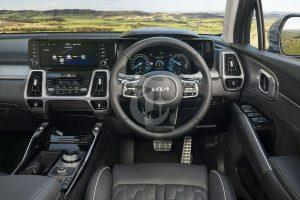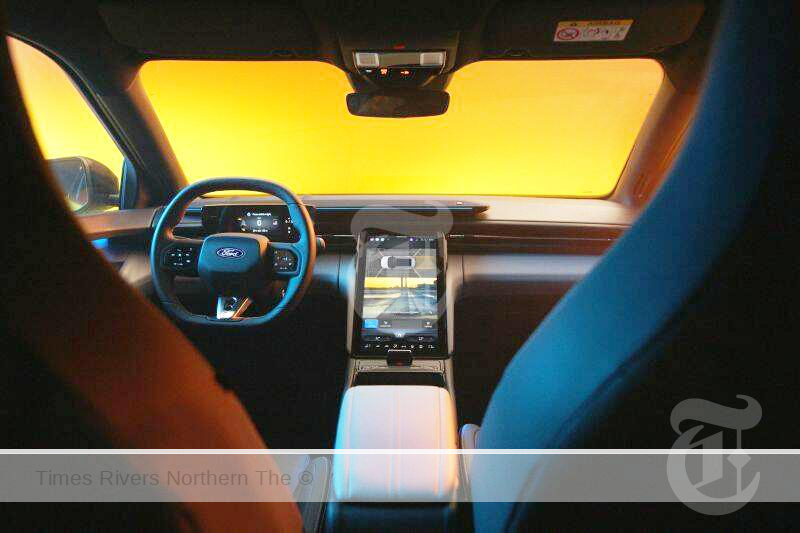POWER PLAY FOR KIA QUIET ACHIEVER
By DEREK OGDEN
The Kia Sorento Hybrid model can be distinguished with reworked front end and unique designer alloy wheels
The Sorento has been a major part of the Kia playbook for two decades, with the fourth generation seeing the light of day in 2020 in petrol and diesel variants. Now the range has been topped up with petrol / electric hybrids.
Kia’s only seven-seat sports utility vehicle comes in the top GT-Line specification only, the straight hybrid version in front or all-wheel drive guise, while the hero model is a plug-in electric hybrid vehicle.
The common-or-garden hybrid Sorento kicks off the range with the front-wheel-drive variant selling for $66,750 before on-road costs. The all-wheel-drive version carries a $3000 premium, pushing the price up to $69,750. The plug-in hybrid Sorento is on sale from $80,330 before on-roads.
More spacious, more versatile with class-leading innovations wrapped in finely tailored style, says the maker, the new Sorento not only is the most high-tech Kia car ever made, but also leads the way in SUV design.
STYLING
While retaining much of the Sorento family physical features, the Hybrid has evolved with a new interpretation of the trademark ‘tiger nose’ grille, with a wider shape wrapping around the integrated LED headlights on each side. This assertive nose is complemented by a wider lower air intake, incorporating wing-shaped air curtains to channel air around the car.
 INTERIOR
INTERIOR
Quilted Nappa leather appointed seats (front heated and ventilated) set the theme for a cabin of quality materials and craftsmanship. Three-stage climate control air-conditioning means comfort all round for occupants, while a panoramic sunroof lets in light, while keeping heat at bay with a blind.
Finding a long journey on the boring side? Take time out to choose one of the 64 colours that bathes the cabin in ambient light, pick something from the Sounds of Nature soundscape, or just switch off entirely with the quiet of the passenger talk in-car intercom.
INFOTAINMENT
Connectivity is front and centre with a 10.25-inch colour multimedia touchscreen linked to
Apple CarPlay and Android Auto. A 7-inch LCD instrument display carries range of system info.
The position of the touch screen on the centre dash of the test car had its problems, with air-con controls underneath easy to catch accidentally while resting the palm on working
the screen.
Audio is handled by a six-speaker system, while dual-zone air-conditioning keeps
occupants in relative comfort.
Customising is the name of the game with a 10.25-inch full colour touchscreen atop the centre console, plus a 12.3-inch digital instrument cluster directly in front of the driver who also has a colour head-up display, including speedo and speed limits on the windscreen.
The touchscreen comes up with Apple CarPlay or Android Auto connectivity, satellite navigation details, including a sharp map display, and access to the 12-speaker Bose audio.
ENGINES / TRANSMISSIONS
The Sorento Hybrid is powered by Kia’s 132 kW / 265 Nm four-cylinder turbo-petrol engine combined with a 44 kW / 264 Nm electric motor, charging a 1kWh lithium-ion battery situated under the boot floor.
Power is put to ground via a six-speed torque converter automatic transmission and constant all-wheel drive.
 SAFETY
SAFETY
The Sorento gained a five-star safety rating in 2020 and includes autonomous emergency braking with vehicle, pedestrian and cyclist detection, junction assist, lane-keep assist, lane follow assist (centring), blind-spot assist, rear cross-traffic alert, parking collision avoidance, adaptive cruise control with stop and / go, front and rear parking sensors, driver attention alert, multi-collision braking and safe exit assist
As well as 360-degree view of the vehicle when parking and blind-spot assist, on activation of a turn indicator, the wide-angle surround view monitors will display live footage of other vehicles in your blind spots on the instrument cluster. It also helps wheels keep their distance from scuffing the sidewalk.
Passive safety is taken care of with seven airbags, including front-centre side.
DRIVING
“Children should be seen and not heard,’ as the saying goes (or went until the Baby Boomers were born). The Kia Sorento Hybrid has slipped quietly (literally) into Australia, harking back to those salad days.
And this well-bred youngster has brought a new purpose to the Sorento family, thanks to a sophisticated powertrain and some of Kia’s most advanced technology.
Setting off is under the auspices of the electric motor alone producing maximum torque on tap instantly. The petrol engine joins in tandem only when needed for added acceleration or under load.
These switches back and forth are so smooth as to undetectable to the driver. Indeed, the only indication that the car is acting only as an electric vehicle is by the letters EV displayed on the instrument panel. It is not possible to control these actions manually; they are automatic powertrain decisions.
Drive modes, such as ECO, Normal, Sport and Smart can be dialled up by means of a centre-console knob. I found Smart worked well for me. Kia claims a combined urban / highway patrol consumption of 5.8 litres per 100 kilometres. The test vehicle recorded 7.1 litres per 100 kilometres in the CBD and suburbs and 5.2 litres per 100 kilometres when let loose on the open road.
Anxiety about where the next battery charge is going to be is none existent as the engine and regenerative braking do that automatically. There is a petrol price premium here as opposed to the cheaper charging of the fully electric, or plug-in hybrid vehicles.
Terrain Select is also on offer to help take care of tricky conditions off road in sand, mud, snow etc.
By activating the turn signal, the wide-angle surround view monitors will display live footage of other vehicles in your blind spots on the instrument cluster.
Loading is made easy by the hands-free smart power tailgate, which can be brought into operation by the key holder pausing behind the vehicle for three seconds for the tailgate to automatically open. There’s 187 litres of cargo space behind the third-row.
Fold these seats flat to increase space to 616 litres. With the second-row seats folded flat 2011 litres of space is freed up.
SUMMARY
The Kia Sorento Hybrid may be a quiet achiever but it states a compelling case for being one of the best large seven-seat sports utility vehicles around.
RATINGS
Looks: 5/10
Performance: 6/10
Safety: 7/10
Thirst: 8/10
Practicality: 8/10
Comfort: 7/10
Tech: 8/10
Value: 6/10
AT A GLANCE
MODEL LINE-UP
S petrol $47,650
Sport petrol $50,270
S diesel $50,650
Sport diesel $53,270
Sport+ petrol $54,850
Sport+ diesel $57,850
GT-Line petrol $62,070
GT-Line diesel $65,070
GT-Line Hybrid FWD $66,750
GT-Line Hybrid AWD $69,750
GT-Line PHEV $80,330
Note: These prices do not include government or dealer delivery charges. Contact your local Kia dealer for drive-away prices.
SPECIFICATIONS (Kia Sorento GT-Line Hybrid 1.6L turbocharged, 4-cylinder petrol engine / electric motor, 1kWh lithium-ion battery, 6sp automatic, AWD SUV)
ENGINE:
Capacity: 1.597 litres
Configuration: Four cylinders inline
Maximum Power: 132 kW
Maximum Torque: 265 Nm
Fuel Type: Regular unleaded petrol
Combined Fuel Cycle (ADR 81/02): 5.8 L/100km
CO2 emissions: 133g/km
Electric motor: 44kW / 264 Nm
Combine Total: 169 kW / 265 Nm
DRIVELINE: Six-speed automatic, all-wheel drive
DIMENSIONS, WEIGHT AND CAPACITIES:
Length: 4472 mm
Wheelbase: 2700 mm
Width: 1841 mm
Height: 1574 mm
Turning Circle: 11.5 metres
Mass (tare): 1530 kg
Fuel Tank Capacity: 55 litres
BRAKES:
Front: Disc
Rear: Disc
STANDARD WARRANTY:
Seven years / unlimited kilometres





 Tweed Shire News2 years ago
Tweed Shire News2 years ago
 Motoring News1 year ago
Motoring News1 year ago
 COVID-19 Northern Rivers News3 years ago
COVID-19 Northern Rivers News3 years ago
 COVID-19 Northern Rivers News3 years ago
COVID-19 Northern Rivers News3 years ago
 Northern Rivers Local News3 years ago
Northern Rivers Local News3 years ago
 Health News3 years ago
Health News3 years ago
 COVID-19 Northern Rivers News3 years ago
COVID-19 Northern Rivers News3 years ago
 NSW Breaking News3 years ago
NSW Breaking News3 years ago





 INTERIOR
INTERIOR SAFETY
SAFETY











